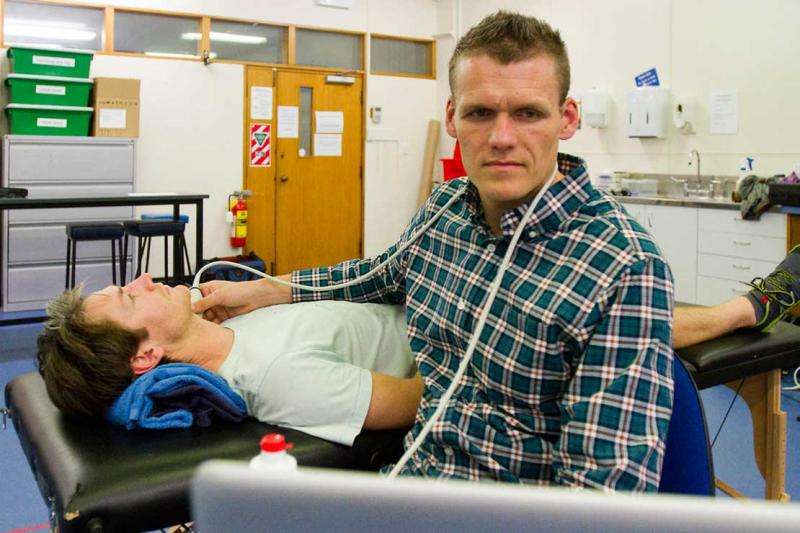Dr Lee Stoner assessing the health of the patient’s carotid artery.
A multinational study, led by Dr Lee Stoner, has identified key priorities that could help prevent heart disease and obesity-related diabetes in indigenous populations.
The study, Principles and Strategies for Improving the Prevention of Cardio-metabolic Diseases in Indigenous Populations: A Delphi Study, was recently completed using independent panels of experts in indigenous cardiovascular and metabolic health from New Zealand, Australia and the United States.
Dr Stoner, from Massey's College of Health in the School of Sport and Exercise, says the study aimed to establish local consensus opinion on appropriate strategies for improving the prevention and management of cardiovascular and metabolic diseases, such as obesity and type 2 diabetes.
Sixty experts (20 from each country) were interviewed using a process called Delphi, which includes three interview rounds. Participants were asked a series of questions relating to disease prevention, consultation with indigenous communities, use of educational resources, societal issues, workforce issues, and the importance of family and culture.
Dr Stoner says, "Some key differences emerged between the three countries, but all experts agreed certain areas need urgent addressing."
These areas were identified as:
- Socio-economic and education inequalities. These should be addressed to minimise several social issues, such as poor education, poor income and poorer access to higher income jobs and drive effective prevention strategies.
- Educational, behaviour change and prevention strategies. These should address environmental factors, such as poor access to space for physical access, and easy access to fast food. It also needs to be culturally appropriate, which can be achieved through consultation with indigenous communities, cultural competency training, use of indigenous health workers, and use of appropriate role models.
Dr Stoner says the findings also indicate there are complex interactions between factors contributing to the indigenous health gap. "It is unlikely a simple strategy focusing on an independent factor will close the gap. For example, primary prevention efforts could be married with policy reform targeting the environmental and social determinants which lead to poor health status in the first place."
Dr Stoner says while there is not yet a concrete example of how indigenous populations can be specifically aided, the study has brought about higher-level thinking. "Primary prevention has been highlighted as an area needing urgent attention. A prime example includes children being encouraged to exercise when they visit primary health care providers. In terms of environmental policy reform, we could ensure equal and equitable access to green space and recreational facilities to encourage exercise.
"While there are a number of big challenges in reducing the indigenous cardiovascular and metabolic health burden, many can be addressed with political will and well-designed policy approaches. Findings from this study indicate a number of key priorities, some of which can be implemented in the medium or short-term."
Dr Stoner led the research in collaboration with Curtin University in Perth, Australia, and Harvard and Western Carolina University in the United States. The project served as the thesis for Dr Stoner's Master of Public Health with Massey's Centre for Public Health Research.
Provided by Massey University






















